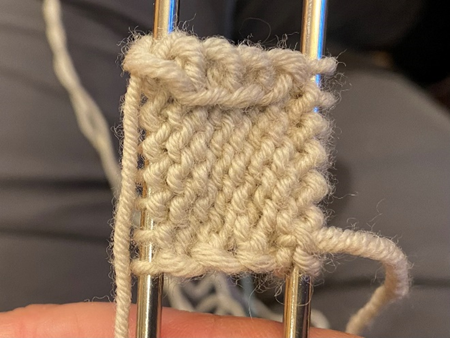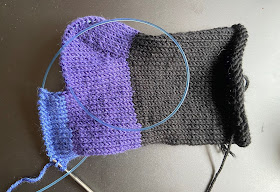Yes I realize it has a funny name. It's an ode to the humor of incorrect autocorrects. The story: I came up with this toe configuration with the help of my friend Brenda Dayne. We text each other a lot, and at the time I was calling this the "banded toe." But my phone kept autocorrecting it to "Bandit Toe." So we decided to just go with it, and named it Banditoe!
The method consists of three basic steps. If you're working toe up:
1. Cast on sts provisionally.
2. Work a small tab back and forth.
3. Shift to working in the round; pick up and knit sts along each
side of the tab, then continue working regular increase rounds until you
reach the target stitch count for the foot.
Instructions
Instructions are written for an 8-stitch band in fingering weight
yarn, 8 or 9 st/inch, but Banditoe can be
worked in whatever width band you choose, and worked to any size, any desired final stitch count.
1. Cast on 16 sts using JMCO (8 sts on each needle), rotate 180°.
2. Starting and ending with a knit row, work 7 rows back and forth in stockinette stitch, slipping the first st pw at the beginning of each. (9 rows total)
3. Shift to working in the round, and continue with toe shaping.
This involves picking up and knitting edge sts using the My Edge
method. Using My Edge is important with Banditoe because the traditional method
leaves a seam on the inside, and especially at the toes I find this is
uncomfortable.
- Pick up and k tbl 4 sts along the edge.
- Once you
have picked up sts along both edges, k22, stop; this leaves the last 2 sts in
the round unworked. Group them with the next 10 sts on one side; 12 st remain
on the other side. The band is now in the middle on each side. Image shows the sts ready for being worked on a magic loop.
Now simply follow the chart below. You may choose whatever increase pattern that works for you; I like to work the first 4 increase rounds consecutively, then the next 5 alternating with a non-shaping round.
Banditoe can also be worked top down. I don’t have a tutorial yet for working in this direction, but conceptually it’s the opposite of the three steps for working toe up:
1. Work regular shaping (decrease) rounds until you are almost at
the tip of the toe.
2. Work a band back and forth a few times, decreasing on each side
(like turning a heel).
3. Graft.


















